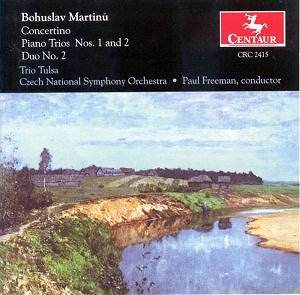Paul Sacher was associated with the Concertino
and the Duo having premiered the former in 1936 with his Basel
Chamber Orchestra and the Trio Hongrois. It was at his home that
Martinů wrote the duo to a commission
by Swiss musicologist, Ernst Mohr.
The Trio Concertino darts
and rushes convulsively in the outer movements. Its second movement
has a most surprising, for Martinů, cosseted lyrical idea
which does not sound at all nationalistic unlike the influences
in the second violin sonata of one year previously. The moderato
theme sounds like a wispy survivor from La Valse. The adagio
digs hoarsely and deeply into a landscape that is expressionistic
and quite unfamiliar. This piece explores avenues which eventually
he decided not to pursue although there are echoes of these moods
in the late Estampes for orchestra. The two middle movements
typify these experiments.
Of the two Piano Trios the First is rife
with Stravinskian activity bumping up against Bachian arioso.
Some of this is pretty dry though always dynamically interesting
as in the player-piano style wildness of the allegro con brio
(tr.9) which flashes along at high velocity. The Second
Trio has those slow stabbing yearning string cries and piano-whisper
ostinati that distinguish the Sinfonietta La Jolla and
the Canzoni of the Toccata e Due Canzoni; classic
mature Martinů. The Duo
No. 2 was written the year before his death and not performed
until after. It was a work of activity, rhythmic interest, not
at all brittle and would pair well with Kodaly's Duo. Given that
only two instruments are involved it fluently sustains
the illusion of a much greater ensemble. The sense of line and
of ineluctable flow is superbly carried off and the brevity of
the movements shows Martinů again making well calculated
judgements about succinct expression. Martinu shows himself a
successor to Dvořák's
American Quartet in the Poco allegro.
There is some inventive and fantastically resourceful
playing from Trio Tulsa on this disc. They are also well recorded.
Take the Poco allegro of the Duo as an example.
Rob Barnett
